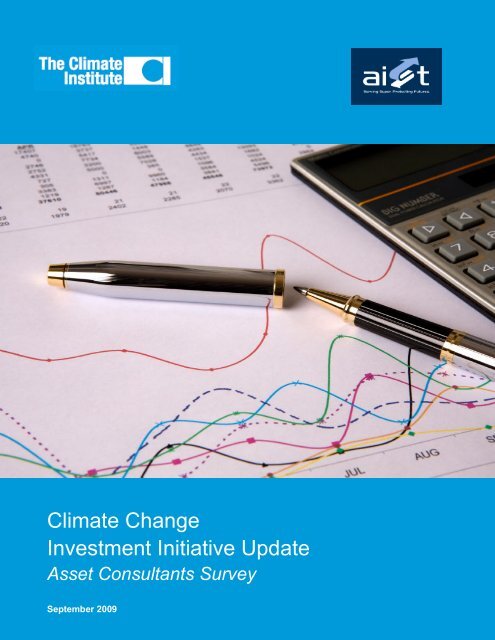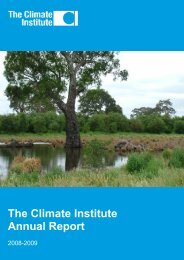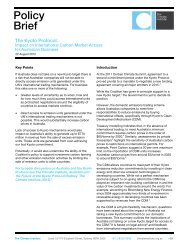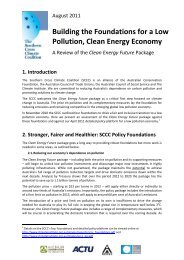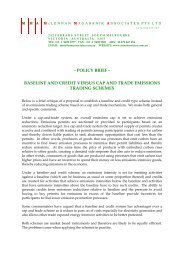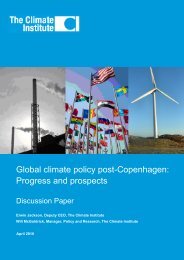Asset Consultants Survey - The Climate Institute
Asset Consultants Survey - The Climate Institute
Asset Consultants Survey - The Climate Institute
Create successful ePaper yourself
Turn your PDF publications into a flip-book with our unique Google optimized e-Paper software.
CLIMATE CHANGE INVESTMENT INITIATIVE UPDATE – <strong>Asset</strong> <strong>Consultants</strong> <strong>Survey</strong>Super<strong>Survey</strong>Report.pdfEn y<strong>Climate</strong> ChangeInvestment Initiative Update<strong>Asset</strong> <strong>Consultants</strong> <strong>Survey</strong>September 2009CLIMATE CHANGE INVESTMENT INITIATIVE UPDATE – <strong>Asset</strong> <strong>Consultants</strong> <strong>Survey</strong> PAGE 1
CLIMATE CHANGE INVESTMENT INITIATIVE UPDATE – <strong>Asset</strong> <strong>Consultants</strong> <strong>Survey</strong>For more information, please contact Julian Poulterjpoulter@climateinstitute.org.au 0402 488 877ISBN: 978-1-921611-01-8PAGE 2CLIMATE CHANGE INVESTMENT INITIATIVE UPDATE – <strong>Asset</strong> <strong>Consultants</strong> <strong>Survey</strong>
CLIMATE CHANGE INVESTMENT INITIATIVE UPDATE – <strong>Asset</strong> <strong>Consultants</strong> <strong>Survey</strong>Contents1. EXECUTIVE SUMMARY __________________________________________ 42. THE CLIMATE CHANGE INVESTMENT INITIATIVE____________________ 72.1. Background of the <strong>Climate</strong> Change Investment Initiative_______ _____ 72.2. Scope and methodology of the <strong>Asset</strong> <strong>Consultants</strong> <strong>Survey</strong> _____ _____ 73. SURVEY RESULTS _____________________________________________ 93.1. <strong>Asset</strong> consulting companies and climate change ____________ _____ 93.2. Investment in climate-change-related assets________________ ____ 113.3. Assesment of portfolio level climate change risk exposure _____ ____ 123.4. Integration of climate change management into services tosuperfund clients _____ ________________________________ ____ 173.5. Collective action ______________________________________ ____ 273.6. Reporting of progress on climate change issues _____________ ____ 284. CONCLUSION_________________________________________________ 295. NEXT STEPS__________________________________________________ 30CLIMATE CHANGE INVESTMENT INITIATIVE UPDATE – <strong>Asset</strong> <strong>Consultants</strong> <strong>Survey</strong> PAGE 3
CLIMATE CHANGE INVESTMENT INITIATIVE UPDATE – <strong>Asset</strong> <strong>Consultants</strong> <strong>Survey</strong>1. Executive summaryBackground<strong>The</strong> Australian <strong>Institute</strong> of Superannuation Trustees (“AIST”) and <strong>The</strong> <strong>Climate</strong> <strong>Institute</strong>launched a survey for asset consultants in June 2009. This survey is critical as it reveals theopinions and capabilities of asset consultants (who advise superfunds on their key strategicdecisions of asset allocation and manager shortlisting) around the area of managing climatechange risks and opportunities.<strong>The</strong> survey was sent to 19 1 of the most active asset consultants in Australia and conductedvia correspondence. <strong>Asset</strong> consultants were given approximately eight weeks for completion.Of the consulting companies invited to respond, nine of the invited companies completed thesurvey. Jointly, the survey respondents had AU$529.4 billion 2 funds under advice inAustralia. Approximately AU$374.9 billion of these funds were made up by Australiansuperannuation funds which also represents 57% of Australia’s AU$662.3 billionsuperannuation assets (excluding pooled superannuation trusts, small APRA funds, singlememberapproved deposit funds (ADFs) and self-managed superannuation funds).Critically, the nine respondents included all the major asset consulting companies servicingAustralian super funds. <strong>The</strong> highest proportion of respondents were either dedicated assetconsulting companies or the asset consulting arm of a broader finance organisation, withboth types of organisations each making up 44% of the total respondents.<strong>The</strong> survey overall shows a ‘mixed bag’ in terms of asset consultants’ preparation for, andcapabilities in, climate change risk. While some firms are PRI signatories and would beexpected to take a leading role, others might have made commercial decisions not to provideclimate-related advice to trustees. As trustees take a more active stance in managing climatechange risk, consultants will need to improve their offering if they want to retain their positionas the preferred advisors to trustees.12<strong>The</strong> consulting survey was initially sent to 20 consulting companies but one had declined to respond as it has sold off itsasset consulting business.This is a minimum amount of funds in Australia under advice as one consulting company only provided the level of fundsunder advice to Australian superfunds. This number was used to calculate the aggregate level of funds under advice inAustralia.PAGE 4CLIMATE CHANGE INVESTMENT INITIATIVE UPDATE – <strong>Asset</strong> <strong>Consultants</strong> <strong>Survey</strong>
CLIMATE CHANGE INVESTMENT INITIATIVE UPDATE – <strong>Asset</strong> <strong>Consultants</strong> <strong>Survey</strong>Results summary<strong>The</strong> key results based on survey responses from the asset consultants are:Awareness of climate change issues• A majority of asset consulting companies surveyed currently have a policy in relation toclimate change in place. Approximately 66% of respondents had climate change issuesincorporated within company policies and a further 11% are planning to introduce apolicy.• Approximately 44% of asset consultants did not participate in any climate change relatedcollaborative engagement initiatives nor are they members of climate change industryassociations• <strong>The</strong>re are limited initiatives carried out around lobbying or dialogue in relation togovernment policy and industry regulation on climate change issues with 78% ofcompanies surveyed having never participated in this at all.Integration of climate change within client services• An overwhelming 89% of respondents consider integrating climate change risks andopportunities as being consistent with their obligations towards superfunds and theservices they need to offer them.• Slightly more than half (56%) of the asset consultants would not accept longer termincentives from clients if suggested.<strong>Climate</strong> change risk management• 89% of respondents are currently approaching these risks in the same way for all clientsdespite superannuation funds having a very different and unique risk profile in that theyinvest for a much longer investment horizon in the best interest of their members. Thismay reflect the early stage of capability development, or it may reflect a failure tounderstand the unique exposure of super funds to climate change risks.• 67% of respondents currently do not offer any services to assess climate change riskexposure. As this is a key element in funds’ response to climate change, consultants mayneed to do more to meet this need.• Only 11% of asset consultants currently offer to analyse the scope 1 and 2 emissions ofsuperfunds’ investments but a further 78% were planning to do so in the next 12 months.• While most of the asset consultants are uncertain as to how the G20 communiqué wouldchange superfunds’ requirements for long-term risk management, 33% believe that therewould be an impact at some point in the future.• Most of the asset consultants (78%) have not considered the impact of climate changelegislation on the value of fossil fuel related investments and furthermore, none of theasset consultants were planning to provide services for clients to be able to calculate theirportfolio wide fossil fuel balance sheet exposures.• 89% of respondents are currently unable to calculate clients’ portfolio level carbonliabilities at a variety of carbon prices and consequently are unable to determine the assetCLIMATE CHANGE INVESTMENT INITIATIVE UPDATE – <strong>Asset</strong> <strong>Consultants</strong> <strong>Survey</strong> PAGE 5
CLIMATE CHANGE INVESTMENT INITIATIVE UPDATE – <strong>Asset</strong> <strong>Consultants</strong> <strong>Survey</strong>class with the highest liability. <strong>Consultants</strong> will need to increase their capabilities if theyare to capture this business from super funds.Client feedback in relation to climate change• Approximately 56% of respondents have offered climate change advice to superfunds butmost of them did not think climate change was important.• <strong>Asset</strong> consultants indicated that superfunds were split evenly managing climate changeissues with 56% of asset consultants having not had any superfund clients request forservices around climate change risks and opportunities and the remaining respondentshaving several requests.• Most respondents (78%) doubted that superfunds were prepared to pay for the necessaryresearch to adequately integrate climate change risks and opportunities into theirservices. Also, 89% of respondents were unsure as to how much more they would needto charge for this.<strong>Asset</strong> allocation and climate change opportunities• Approximately 44% of asset consultants would only advise their clients to considerimplementing climate change or carbon as an asset class depending on their portfolio orneeds and 33% would only do so at clients’ request. 11% responded that they providethis advice for all clients.• 33% of respondents thought that climate change risk should be partly managed viaspecific allocations in the asset allocation strategy (either through investments across allor specific asset classes). A majority (78%) did not believe that there was a certaindesirable range of portfolio that should be allocated to climate change related assets.• Most of the asset consultants (67%) had not provided any advice to clients on investingcollectively in climate change opportunities.• 33% of consultants use specific research from third parties to assess climate change risk.Capacity and capability for dealing with climate change• While asset consultants are still in their infancy in managing climate change issues, mostof the respondents (78%) had sufficient staff to deal with climate change issues withslightly more than half (56%) having a specific executive responsible for dealing withclimate change issues or client advice in the area.. Approximately 80% were planning tofurther increase their capacity through internal and external measures.Implications for investment managers• Only 11% of respondents currently do not integrate climate change risks andopportunities to any degree into the rating and selection of fund managers• Approximately 56% of consultants would not advise their clients to restructure eitherexisting or new mandates to account for climate change risks and opportunities• Majority (67%) of respondents believed that longer term incentives for fund managerswould assist superfunds in managing long-term risks.PAGE 6CLIMATE CHANGE INVESTMENT INITIATIVE UPDATE – <strong>Asset</strong> <strong>Consultants</strong> <strong>Survey</strong>
CLIMATE CHANGE INVESTMENT INITIATIVE UPDATE – <strong>Asset</strong> <strong>Consultants</strong> <strong>Survey</strong>2. <strong>The</strong> <strong>Climate</strong> Change Investment Initiative2.1 Background of the <strong>Climate</strong> Change Investment InitiativeIn September 2008, <strong>The</strong> Australian <strong>Institute</strong> of Superannuation Trustees (“AIST”) and <strong>The</strong><strong>Climate</strong> <strong>Institute</strong> jointly initiated the “<strong>Asset</strong> Owners <strong>Climate</strong> Change Initiative”, now knownas the “<strong>Climate</strong> Change Investment Initiative”. <strong>The</strong> first phase of this initiative involved asurvey for asset owners including not-for-profit superannuation funds, master trusts and thegovernment-backed Future Fund. 3 Seventy three of Australia’s largest super funds with $1billion under management were invited to participate in the survey, which assessed funds’preparation in managing the risks and realising the opportunities associated with climatechange and its effects on their operations and investment portfolios.In March 2009, the results from the inaugural survey were released at AIST’s Conference ofMajor Superannuation Funds where more than 40% of invited funds responded to the survey,making the survey participation rate very comparable to the response rate of the first CarbonDisclosure Project (“CDP”) conducted in 2003 of which 44% of the top 500 global companiesresponded to the questionnaire. 4<strong>The</strong> survey respondents represented AU$300 billion of assets and almost 40% of the ‘largefunds’ sector that includes public offer funds, corporate funds, industry funds, public sectorfunds and retail master trusts.Building on the success of the superfund survey in its first year, the initiative wassubsequently expanded to asset consultants.2.2 Scope and methodology of the <strong>Asset</strong> <strong>Consultants</strong> <strong>Survey</strong>In June 2009, AIST and <strong>The</strong> <strong>Climate</strong> <strong>Institute</strong> launched a survey for asset consultants. Thissurvey is critical as it reveals the opinions and capabilities of asset consultants (who advisesuperfunds on their key strategic decisions of asset allocation and manager shortlisting)around the area of managing climate change risks and opportunities.<strong>The</strong> survey was sent to 19 5 of the most active asset consultants in Australia and inquired tothe consulting services provided to superfunds on the following areas:• <strong>Climate</strong> change and asset allocation issues• Integrating climate change capability into manager shortlisting• Investment in climate change related assets• Assessment of portfolio level climate change risk exposure345<strong>The</strong> Future Fund is an independent government-backed investment fund that was established by the Future Fund Act 2006to assist future Australian governments in meeting the cost of public sector superannuation liabilities by deliveringinvestment returns on contributions to the Fund.Sourced from the “Carbon Disclosure Project Report 2003” (http://www.cdproject.net/download.asp?file=cdp_report.pdf)<strong>The</strong> consulting survey was initially sent to 20 consulting companies but one had declined to respond as it has sold off itsasset consulting business.CLIMATE CHANGE INVESTMENT INITIATIVE UPDATE – <strong>Asset</strong> <strong>Consultants</strong> <strong>Survey</strong> PAGE 7
CLIMATE CHANGE INVESTMENT INITIATIVE UPDATE – <strong>Asset</strong> <strong>Consultants</strong> <strong>Survey</strong>• Integration of climate change management into asset consultants’ services tosuperfund clients• Collective action• Reporting of progress on climate change issues• Integrating opportunities in climate change<strong>The</strong> survey was conducted via correspondence and asset consultants were givenapproximately 8 weeks for completion. <strong>The</strong> invitations for response were delivered to thesenior management of each consulting company (i.e. Chief Executive Officer, ManagingDirector, Partner, Chief Operating Officer and/or Principal) and where identified, to otherknown executives with main responsibility in this area.Out of the 19 consulting companies 6 invited to respond to the survey, 47% of the companiescompleted the survey. Jointly, the survey respondents had AU$529.4 billion 7 funds underadvice in Australia. Approximately AU$374.9 billion of these funds were made up byAustralian superannuation funds which also represents 57% of Australia’s AU$662.3 billionsuperannuation assets (excluding pooled superannuation trusts, small APRA funds, singlememberapproved deposit funds (ADFs) and self-managed super funds).Critically, all the major asset consulting companies responded to the survey. <strong>The</strong> highestproportion of respondents were either dedicated asset consulting companies or the assetconsulting arm of a broader finance organisation, with both types of organisations eachmaking up 44% of the total respondents.Breakdown of Respondents (%)Dedicated <strong>Asset</strong>ConsultingCompany, 44%<strong>Asset</strong> Consultingarm of a broaderfinanceorganisation,44%Other , 11%67<strong>The</strong> consulting survey was initially sent to 20 consulting companies but one had declined to respond as it has sold off itsasset consulting business.Note that this number is a minimum amount of funds in Australia under advice as one consulting company only provided thelevel of funds under advice to Australian superfunds. This number was used to calculate the aggregate level of funds underadvice in Australia.PAGE 8CLIMATE CHANGE INVESTMENT INITIATIVE UPDATE – <strong>Asset</strong> <strong>Consultants</strong> <strong>Survey</strong>
CLIMATE CHANGE INVESTMENT INITIATIVE UPDATE – <strong>Asset</strong> <strong>Consultants</strong> <strong>Survey</strong>3. <strong>Survey</strong> results3.1. <strong>Asset</strong> consulting companies and climate changeResults from the survey indicated that consulting companies have begun some action andinitiatives towards climate change management at an operational level. <strong>The</strong> majority of theconsulting companies (66%) had climate change issues incorporated within company policiesand a further 11% planning to introduce this.Q2.1 Are climate change issues integrated into your broader company policies, your overallESG policy or do they form a stand-alone policy? Please select one option.Response %No policy on climate change 22%<strong>Climate</strong> change included in broader investment policy only 22%We have both integrated and standalone policies 22%<strong>Climate</strong> change included in overall ESG policy 11%Integrated policy 11%Planning to introduce policy 11%Total 100%Only 11% of the respondents did not have any measures taken to limit its own emissions.<strong>The</strong> remaining respondents took at least one measure, of which green building practice wasthe most popular option chosen, with 44% of respondents opting for this. This was followedby recycling initiatives (33%) and staff education programmes (22%).Q2.2 Which of the following measures do you take as a firm to limit your own netemissions?*Note that more than one option can be selectedResponse %Green building practice 44%Others (such as paper and waste recycling and emissions awarenessactivities)33%Staff education programmes 22%No measures taken 11%Carbon reduction programmes 11%Offsets 11%CLIMATE CHANGE INVESTMENT INITIATIVE UPDATE – <strong>Asset</strong> <strong>Consultants</strong> <strong>Survey</strong> PAGE 9
CLIMATE CHANGE INVESTMENT INITIATIVE UPDATE – <strong>Asset</strong> <strong>Consultants</strong> <strong>Survey</strong><strong>The</strong> survey results also demonstrated that asset consulting firms were not particularly activein participating in the debate around climate change. Very limited initiatives were carried outaround lobbying or dialogue in relation to government policy and industry regulation onclimate change issues. 78% of companies surveyed had never participated in this at all.However, it may be the case that asset consultants see this primarily as the responsibility oftrustees.Q2.3 Have you engaged in dialogue, lobbying or initiatives pertaining to government policyand/or industry regulations (i.e., stock exchanges, accounting standards) related to climatechange issues? Please select one option.Response %Not at all 78%To a large extent 11%To a small extent 11%Planning to in the next 12 months -%Total 100%Incorporating climate change within services provided to clients<strong>The</strong>re was unequivocal evidence demonstrating that the biggest driver for asset consultantsto integrate climate change would be if there was a significant demand from their clients. Notonly did an overwhelming 89% of respondents consider integrating climate change risks andopportunities as being consistent with their obligations towards superfunds, but the primarymethod of which climate change has been emphasised as a priority so far has been as partof the delivery of client services.Q2.4 Does your firm consider integrating climate change risk / opportunity into investmentpolicy / strategy as being consistent with your obligations to providing client services tosuperfunds? Please select one option.Response %Yes 89%No 11%Total 100%PAGE 10CLIMATE CHANGE INVESTMENT INITIATIVE UPDATE – <strong>Asset</strong> <strong>Consultants</strong> <strong>Survey</strong>
CLIMATE CHANGE INVESTMENT INITIATIVE UPDATE – <strong>Asset</strong> <strong>Consultants</strong> <strong>Survey</strong>Q2.6 To what extent do you communicate to the investment community that climatechange should be a priority? Please select one option.Response %As part of delivering client services 44%Not at all 22%Other (such as via investment advice and professional events) 22%In wider industry communication 11%In marketing communications directly to clients -%As part of general branding -%Total 100%More work needs to be done in relation to asset consultants’ approach in assessingsuperfunds’ climate change risks. Respondents to the survey indicated that climate changerisks were currently being approached in the same manner as other clients when superfundshave a very different and unique risk profile in that they invest for a much longer investmenthorizon in the best interest of their members.Q2.7 Do you have a different approach to climate change risks for superfunds and your otherclients?Response %Yes 11%No 89%Only have super fund clients -%Total 100%3.2. Investment in climate-change-related assets<strong>Survey</strong> results indicated that most asset consultants would only advise their clients toconsider implementing climate change or carbon as an asset class depending on theirportfolio or needs (44%) and at clients’ request (33%). While this is reasonable, the advicewould only be accurate if analysis of the client’s portfolio had incorporated considerations ofclimate change risks. If not, the advice would not reflect the full extent of risks within theportfolio. Notably, a vast majority of asset consultants (78%) do not even provide services tosuperfunds to determine their investments in climate change related assets.Notably, a vast majority of asset consultants (78%) do not even provide services tosuperfunds to determine their investments in climate change related assets.CLIMATE CHANGE INVESTMENT INITIATIVE UPDATE – <strong>Asset</strong> <strong>Consultants</strong> <strong>Survey</strong> PAGE 11
CLIMATE CHANGE INVESTMENT INITIATIVE UPDATE – <strong>Asset</strong> <strong>Consultants</strong> <strong>Survey</strong>Q3.1 To what extent will you be advising clients in the future to consider implementingclimate change or carbon as an asset class?*Note that more than one option can be selectedResponse %For some clients, depending on their portfolio or needs 44%When clients request this 33%Will be considering the issue in the next 12 months 22%For all clients 11%Not at all -%Q3.2 Do you provide services or advice to superfund clients to enable them to calculate thetotal value of their investments in climate change related assets?Response %Yes 11%No 78%Other (by recommending specialists) 11%Total 100%3.3. Assessment of portfolio level climate change risk exposureIn relation to long-term risk management, there was a lot of uncertainty from the majority ofthe respondents at this point as to how the G20 communiqué would change superfunds’requirements, with 33% believing that there would be an impact at some point in the futureand 44% undecided.Q4.1 Do you believe that the G20 communiqué on long-term risk management will have animpact on how your superfund clients will be required to manage long-term risk?Response %Yes 11%No 11%Yes, at some point in the future 33%Not sure at this stage 44%Total 100%Substantial improvements are required from asset consulting firms in the area of riskmanagement relating to climate change, with 67% of respondents not offering any services toassess climate change risk exposure. It was promising however to note that while only 11%PAGE 12CLIMATE CHANGE INVESTMENT INITIATIVE UPDATE – <strong>Asset</strong> <strong>Consultants</strong> <strong>Survey</strong>
CLIMATE CHANGE INVESTMENT INITIATIVE UPDATE – <strong>Asset</strong> <strong>Consultants</strong> <strong>Survey</strong>of asset consultants currently offer to analyse the scope 1 and 2 emissions of superfunds’investments, a further 78% were planning to do so in the next 12 months.Q4.2 Do you offer services to your clients to assess climate change risk exposure?Response %No 67%Yes, on certain assets only 11%Yes, across equities only -%Yes, across all asset classes 22%Planning to in the next 12 months -%Total 100%Q4.3 What type of services do you provide to superfund clients to calculate any risksrelating to climate change?*Note that more than one option can be selectedResponse %None 67%Equity portfolio footprints 11%Equity portfolio footprint projections 11%Equity portfolio carbon strategies 11%<strong>Climate</strong> change scenario modelling 11%Complete holistic portfolio level view of climate risk 11%Physical impact analysis -%Embedded debt risk -%Other -%Q4.4 Do you offer your superfund clients services to analyse the scope 1 and 2 emissionsof their held investments (tonnes CO2e)?Response %Yes 11%No -%Planning to in the next 12 months 78%Will be working with fund managers on this issue 11%Total 100%Consistent with expectations, as asset consultants are only beginning to look at climatechange related risks, the majority of respondents are currently unable to quantify any liabilityCLIMATE CHANGE INVESTMENT INITIATIVE UPDATE – <strong>Asset</strong> <strong>Consultants</strong> <strong>Survey</strong> PAGE 13
CLIMATE CHANGE INVESTMENT INITIATIVE UPDATE – <strong>Asset</strong> <strong>Consultants</strong> <strong>Survey</strong>related to them. Overwhelmingly 89% of respondents had no current methods to calculateclients’ portfolio level carbon liabilities at a variety of carbon prices and subsequently couldnot determine the asset class with the highest liability. This indicated that asset consultantswill need to be better prepared in order to be able to service their clients on this matter,particularly superfunds.Q4.5 Do you have methods in place to calculate your client’s portfolio level carbon liabilitiesand opportunities (gross with no pass through analysis) at a variety of carbon prices from $20per tonne CO2e to $100 per tonne CO2e?Response %No current methods 89%Have methods in place now 11%Planning to implement methods in the next 12 months -%Total 100%Q4.6 For your superfund clients, can you calculate what classes of asset have the highestpercentage liability at high carbon prices (say between $40 and $100) in their currentportfolio constructions?*Note that more than one option can be selectedResponse %Not known 67%Planning to calculate in the next 12 months 11%Australian equities 11%International equities 11%All classes are equally affected -%Fixed income -%Property -%Infrastructure -%Other alternatives -%Most of the asset consultants (67%) indicated that they would be advising their clients tointegrate research into their assets with high climate change impact in order to manage theclimate change risks. It’s also most likely that specific research from specialist third partieswould be incorporated in order to assess climate change risks (33% of respondents electedthis), with policy implications at the macroeconomic levels, the EU and Australian carbonprices being the main inputs used for climate change risk assessments.PAGE 14CLIMATE CHANGE INVESTMENT INITIATIVE UPDATE – <strong>Asset</strong> <strong>Consultants</strong> <strong>Survey</strong>
CLIMATE CHANGE INVESTMENT INITIATIVE UPDATE – <strong>Asset</strong> <strong>Consultants</strong> <strong>Survey</strong>Q4.7 How are you advising your clients to manage the risk to assets in high climate changeimpact sectors held in their portfolios (e.g. high emitters, insurance companies etc)?Response %Integrated research into individual asset risks 67%Not at all 11%Planning to consider this in the next 12 months 11%Balancing risks across asset classes 11%By investing in counter balancing assets that will benefit from either carbonprice rises, policy or physical impacts.-%Total 100%Q4.11 What other methods do you use to assess climate change risk?Response %None 44%Specific research from specialist third parties 33%Judgement of climate change risks as a whole, in relation to client’s long-termobligations to members11%Other (e.g. further research and scenario analysis) 11%Specific in-house research -%Total 100%Q4.12 What inputs are you using when considering climate change analysis?*Note that more than one option can be selectedResponse %None 44%Possible policy implications at a macroeconomic or systemic level 44%Current EU carbon price 22%Likely Australian carbon prices 22%Other inputs (e.g. the extent to which carbon has already been factored into themarket pricing and also inputs recommended by research specialists)22%Carbon futures from a research house -%Carbon futures from emissions pathways models -%Physical risk impact data -%CLIMATE CHANGE INVESTMENT INITIATIVE UPDATE – <strong>Asset</strong> <strong>Consultants</strong> <strong>Survey</strong> PAGE 15
CLIMATE CHANGE INVESTMENT INITIATIVE UPDATE – <strong>Asset</strong> <strong>Consultants</strong> <strong>Survey</strong>Results from the survey demonstrated that almost all of the asset consultants have notconsidered the impact of climate change legislation to the value of fossil fuel relatedinvestments. Most of the asset consultants (78%) have not considered this impact oncompany’s fossil fuel reserves and furthermore, none of the asset consultants were planningto provide services for clients to be able to calculate their portfolio wide fossil fuel balancesheet exposures.Q4.8 Recent Nature research highlighted that there are sufficient physical fossil fuelreserves (proven and probable) on investee company balance sheets to exceed the likelyforthcoming target policy agreements of 450ppm Co2-e? Are you aware of this research andwould you consider this in your advice to superfunds given the current state of variousrecycling technologies?Response %No 78%Yes 11%Did not provide response 11%Total 100%Q4.9 Would such research affect the advice you gave clients on investing in explorationassets?Response %Maybe, depending on client’s investment policy or portfolios 44%Yes 22%No 22%Did not provide response 11%Total 100%Q4.10 Do you plan to provide services for clients to be able to calculate portfolio wide fossilfuel balance sheet exposures?Response %No 100%Planning to in the next 12 months -%Yes, physical and debt related exposures -%Physical exposures only -%Debt related exposures only -%Total 100%PAGE 16CLIMATE CHANGE INVESTMENT INITIATIVE UPDATE – <strong>Asset</strong> <strong>Consultants</strong> <strong>Survey</strong>
CLIMATE CHANGE INVESTMENT INITIATIVE UPDATE – <strong>Asset</strong> <strong>Consultants</strong> <strong>Survey</strong>In relation to a timeline for considering risks and opportunities, approximately 55% of assetconsultants responded that the shortest time frame within which a risk or opportunity wouldneed to be evidenced for them to be able to make a recommendation was 3 years or more.Q4.13 In order for a risk or opportunity to be considered by your research staff, what is theshortest time frame it needs to be evidenced in returns for you to make a recommendationtoday:Response %3 years 33%Longer than 3 years 22%1 year 22%No minimum time frame / Did not respond 22%2 years -%Total 100%3.4. Integration of climate change management into services to superfundclientsIn the move towards incorporating climate change considerations, results from the surveyindicated that asset consultants believed that more active investment measures would benecessary to adequately address this. 56% of respondents thought that passive investmentstrategies were inadequate in addressing long-term risks, and a further 22% felt that passivestrategies would only be adequate if combined with other techniques.Q5.2 Regarding portfolio construction, do you believe that passive investment strategiescan adequately deal with long-term risks such as climate change?Response %No, the nature of those strategies exposes them to climate change risks andopportunities.56%Yes 11%Yes, if used in conjunction with a hedging or balancing strategy 11%Yes, by allowing a permissible tracking error to account for balancing climatechange risk.11%Did not respond 11%Total 100%Despite the current lack of incorporation of climate change issues within the regularinvestment process, it was very encouraging to find that 56% of respondents have providedadvice which led to climate change related investment decisions. Renewable energyinvestments was the most common outcome of this applying to 33% of respondents.CLIMATE CHANGE INVESTMENT INITIATIVE UPDATE – <strong>Asset</strong> <strong>Consultants</strong> <strong>Survey</strong> PAGE 17
CLIMATE CHANGE INVESTMENT INITIATIVE UPDATE – <strong>Asset</strong> <strong>Consultants</strong> <strong>Survey</strong>Q5.4 Can you give examples of climate change related investment decisions your advicehas influenced?*Note that more than one option can be selectedResponse %We do not advise on climate risks or opportunities 44%Allocation of money to renewable energy 33%Individual investments from clients 22%Allocation of money to cleantech 11%<strong>Climate</strong> change bonds / other financial products 11%Carbon hedging of equities risk -%Carbon offsets -%Consistent with results from earlier sections, there appears to be insufficient incentives fromsuperfunds to drive asset consultants into incorporating climate change. Approximately 56%of respondents have offered climate change advice to superfunds but most of these funds‘did not think climate change was important’. When asked why they thought trustees held thisview, asset consultants thought that this was largely due to the ‘herd mentality of superfundsbeing reluctant to lead’ (33%) and also that the ‘investment chain was still geared towardsthe short term’ (33%). Consequently, 56% of asset consultants have not had any superfundclients request for services around climate change risks and opportunities.Q5.5 Regarding how superfunds perceive your advice on climate change generally:Response %We have offered advice but most clients don’t think its important 56%We haven’t given any advice in this area 44%Most clients are concerned about climate change and consider all our advicein this area-%Total 100%PAGE 18CLIMATE CHANGE INVESTMENT INITIATIVE UPDATE – <strong>Asset</strong> <strong>Consultants</strong> <strong>Survey</strong>
CLIMATE CHANGE INVESTMENT INITIATIVE UPDATE – <strong>Asset</strong> <strong>Consultants</strong> <strong>Survey</strong>Q5.6 What is the main reason you think superfunds take little action climate change?*Note that more than one option can be selectedResponse %Other (Reasons provided include more financial analysis required, requirementof greater clarity around pricing and policy, too difficult and the need fortrustees to put more pressure on their fund managers as investment decisionsare largely delegated to them)67%Herd mentality – funds are reluctant to lead 33%<strong>The</strong> investment chain is still geared towards the short term 33%<strong>The</strong>y believe it conflicts with their fiduciary duty 11%<strong>The</strong>y just don’t perceive the urgency 11%Trustees are powerless – fund executives make the decisions -%<strong>The</strong>y refuse to use low discount rates on long-term investments -%<strong>The</strong>y are not advised well -%Q5.7 How many super fund clients have requested services around climate change risksand opportunities?Response %None 56%A few 44%Most -%All -%Total 100%Most respondents (78%) did not think that superfunds were prepared to pay for thenecessary research to adequately integrate climate change risks and opportunities into theirservices. 89% of respondents were also unsure as to how much more they would need tocharge for this.Q5.12 Does your firm consider that superfunds are prepared to pay for the necessaryresearch for your firm to adequately integrate climate change risk and opportunity into yourservices?Response %Yes 22%No 78%Total 100%CLIMATE CHANGE INVESTMENT INITIATIVE UPDATE – <strong>Asset</strong> <strong>Consultants</strong> <strong>Survey</strong> PAGE 19
CLIMATE CHANGE INVESTMENT INITIATIVE UPDATE – <strong>Asset</strong> <strong>Consultants</strong> <strong>Survey</strong>Q5.13 How much extra would your firm need to charge on top of existing fees for you toadequately integrate climate change risks and opportunities into your services?Response %Not sure 78%Approximately ____% on top of our current fees 11%Planning to calculate in the next 12 months 11%Nothing extra -%Total 100%<strong>Climate</strong> change risks managementOnly 33% of respondents thought that climate change risks should be partly managed viaspecific allocations in the asset allocation strategy (either through investments across all orspecific asset classes). Majority (78%) did not believe that there was a certain desirablerange of portfolio that should be allocated to climate change related assets. However, mostof them had not yet considered what the best measure was for hedging against suddenrepricing events due to climate change. 33% of respondents were planning to consider this inthe next 12 months, and 11% did not know what the best hedging strategy was.Notably, the strategy of implementing positive and/or negative climate change relatedscreens on the investment process were evenly split between asset consultants.Q5.8 Do you believe that climate change risk should be partly managed via specificallocations in their asset allocation strategy?Response %No 67%Yes, through specific investments across all asset classes 22%Yes, through specific investments in particular asset classes 11%Total 100%PAGE 20CLIMATE CHANGE INVESTMENT INITIATIVE UPDATE – <strong>Asset</strong> <strong>Consultants</strong> <strong>Survey</strong>
CLIMATE CHANGE INVESTMENT INITIATIVE UPDATE – <strong>Asset</strong> <strong>Consultants</strong> <strong>Survey</strong>Q5.9 What do you believe are the best balancing or hedging strategies for exposed sectorsagainst a sudden and large rise in carbon price caused by a sudden or rapid regulatory policyintervention in response to climate change?Response %Planning to consider this issue in the next 12 months 33%Optimising equity portfolios to overweight companies with high quality carbonstrategies in carbon-intensive sectorsOther (Responses provided include diversification to manage risks andquantifying of carbon risks and management)22%22%Don’t know 11%Balancing investment opportunities in low carbon assets 11%It is not important as emissions trading in Australia is unlikely for some time -%Use of put options on high risk sectors -%Use of overlays -%Total 100%Q5.10 Do you think there is a desirable % range of a portfolio that should be allocated toclimate change related assets?Response %Yes 22%No 78%Total 100%Q5.22 Do you recommend to any clients to apply any formal climate change screens in theirinvestment process?Response %No 56%Yes, positive screens 22%Yes, negative screens 11%Yes, positive and negative screens 11%No, but planning to in the next 12 months -%Total 100%CLIMATE CHANGE INVESTMENT INITIATIVE UPDATE – <strong>Asset</strong> <strong>Consultants</strong> <strong>Survey</strong> PAGE 21
CLIMATE CHANGE INVESTMENT INITIATIVE UPDATE – <strong>Asset</strong> <strong>Consultants</strong> <strong>Survey</strong>Capacity for dealing with climate change issuesIn terms of human resource capacity and capability, the asset consultants demonstrated thatthey were committed in providing the adequate resources to deal with climate change issues.Approximately 78% of the asset consultants were currently capable of dealing with climatechange issues and 80% were planning to further increase their capacity through internal andexternal measures. Slightly more than half of the respondents (56%) had a specific executiveresponsible for dealing solely with climate change issues or client advice in the area.Only 22% of asset consultants currently use a third party data company for climate changeresearch or appoint advisers, however a further 22% were looking to do this in the next 12months.Q5.14 Do you already have capacity and capability for dealing with climate change issues?Response %Yes, we have staff 56%No 22%Yes, we conduct staff training 11%Yes, we hire external consultants 11%Yes, through other areas (Please specify) -%Total 100%Q5.15 Do you plan to increase your capacity and capability for dealing with climate changeissues?Response %No 20%Yes, through training 50%Yes, through hiring staff 10%Yes, through hiring external consultants 20%Yes, through other areas -%Total 100%Q5.16 Do you have a named executive responsible for dealing with climate change issues orclient advice in this area?Response %Yes 56%No 44%Total 100%PAGE 22CLIMATE CHANGE INVESTMENT INITIATIVE UPDATE – <strong>Asset</strong> <strong>Consultants</strong> <strong>Survey</strong>
CLIMATE CHANGE INVESTMENT INITIATIVE UPDATE – <strong>Asset</strong> <strong>Consultants</strong> <strong>Survey</strong>Q5.27 Do you use a third party data company for climate change research or instruct anyadviser to do so?Response %No 56%Yes 22%No but planning to in the next 12 months 22%Total 100%Appointment of fund managers<strong>The</strong> survey results indicated that procedures relating to the appointment of fund managershave started incorporating climate change considerations. All respondents had to somedegree assessed the external investment managers on the extent to which they wereintegrating climate change issue analysis, with 44% of respondents rating and selecting fundmanagers of selected classes based on this.Moreover, 33% of respondents have already altered or plan to in the next 12 months alter theshortlisting process of investment managers to reflect integration of climate change researchand 11% plan to alter the shortlisting process to incorporate climate change opportunities.Q5.23 Have you assessed your clients external investment managers on the extent to whichthey are integrating climate change issue analysis?Response %No -%Yes, broad assessment 67%Yes, detailed assessment 11%Planning to in the next 12 months 22%Total 100%CLIMATE CHANGE INVESTMENT INITIATIVE UPDATE – <strong>Asset</strong> <strong>Consultants</strong> <strong>Survey</strong> PAGE 23
CLIMATE CHANGE INVESTMENT INITIATIVE UPDATE – <strong>Asset</strong> <strong>Consultants</strong> <strong>Survey</strong>Q5.1 Do you integrate climate change risks and opportunities into the rating and selectionof fund managers?Response %Yes, in specific asset classes only 44%Yes, always 22%Yes, but only when directed to by a client 11%No 11%Yes, depending on other factors (such as how material the risks are) 11%Planning to in the next 12 months -%Total 100%Q5.20 Have you already altered, or do you have plans in the next 12 months to alter, yourshortlisting for investment managers to reflect any of the following?*Note that more than one option can be selectedResponse %Integration of climate change research 33%<strong>Climate</strong> change opportunities 11%Mandatory signatory of UNPRI, EAI, ESGRA or GRI 11%Retained bonuses / options for long-term return 11%Other incentive alignments (such as fees) 11%Greater mandate length -%Longer investment horizons -%Other climate change issues -%Did not respond 33%While the proportion of consultants that advise their clients to restructure either existing ornew mandates to account for climate change risks and opportunities are fairly evenly split(56% would not), most of the asset consultants (67%) would recommend a standardmandate length to superfunds. <strong>The</strong> average recommended length was generally 4 years. Asimilar portion (67%) also believed that longer term incentives for fund managers wouldassist superfunds in managing long-term risks.PAGE 24CLIMATE CHANGE INVESTMENT INITIATIVE UPDATE – <strong>Asset</strong> <strong>Consultants</strong> <strong>Survey</strong>
CLIMATE CHANGE INVESTMENT INITIATIVE UPDATE – <strong>Asset</strong> <strong>Consultants</strong> <strong>Survey</strong>Q5.24 Do you advise your clients to restructure either existing or new mandates to accountfor climate change risks and opportunities?Response %Yes 11%Not at all 56%Not applicable -%To a large extent -%To a moderate extent 11%To a small extent 22%No but planning to in the next 12 months -%Total 100%Q5.18 What are your current recommended standard mandate lengths for shortlistedinvestment managers in years?67% of respondents provided the average recommended standard mandate lengths, whichwere generally 4 years on average. 22% of respondents did not provide recommendationsand left it to the client whereas 11% of the respondents recommended the mandate be anongoing one.Q5.19 Do you believe that using longer term incentives for fund managers will assist yourclients to manage long-term risks such as climate change?Response %Yes 67%No 33%Total 100%<strong>The</strong> asset classes which were most likely to incorporate climate change issues were listedequities and real estate (applicable to 67% of respondents) followed by private equity andinfrastructure investments (applicable to 44% of respondents).CLIMATE CHANGE INVESTMENT INITIATIVE UPDATE – <strong>Asset</strong> <strong>Consultants</strong> <strong>Survey</strong> PAGE 25
CLIMATE CHANGE INVESTMENT INITIATIVE UPDATE – <strong>Asset</strong> <strong>Consultants</strong> <strong>Survey</strong>Q5.21 Please indicate into which asset classes climate change issues are beingincorporated by your external investment managers as part of their defined investmentprocess. Please select all that apply.Response %Equity (listed) 67%Real estate 67%Private equity 44%Infrastructure 44%Other (alternatives and agriculture) 22%Emerging market equity (listed) 11%Fixed income -%Hedge funds -%None -%Q5.17 What are your current standard mandate lengths with your clients (Please providemean or range)?<strong>The</strong> average mandate lengths were approximately 3.4 years.Q5.25 Have you suggested to your clients that they alter your own mandates to reflect anyof the following?*Note that more than one option can be selectedResponse %No 67%Greater mandate length 11%Longer investment horizons 33%<strong>Climate</strong> change opportunities -%Integration of climate change research 11%Retained bonuses for long-term return (Please specify over what time horizonand what KPIs would you employ11%Q5.26 Would you accept longer term incentives from your clients if they suggested them?Response %Yes 11%No 56%Maybe 22%Did not respond 11%Total 100%PAGE 26CLIMATE CHANGE INVESTMENT INITIATIVE UPDATE – <strong>Asset</strong> <strong>Consultants</strong> <strong>Survey</strong>
CLIMATE CHANGE INVESTMENT INITIATIVE UPDATE – <strong>Asset</strong> <strong>Consultants</strong> <strong>Survey</strong>3.5. Collective actionMost of the asset consultants (67%) had not provided any advice to clients on investingcollectively in climate change opportunities. <strong>The</strong> number of respondents that participated incollaborative engagement initiatives relating to climate change was also fairly even, with 56%of respondents engaging in at least one collaborative initiative.Q6.1 Have you provided advice to clients on methods of investing collectively on climatechange opportunities with other superfunds or other organisations to enhance returns?Response %No 67%Yes, joint infrastructure investments -%Yes, via formal collaboration initiatives 11%Yes, other (through fund managers) 22%Total 100%Q6.2 Please check all the collaborative engagement initiatives and/or industry associationsyou participate in.*Note that more than one option can be selectedResponse %None 44%Other (including UNPRI and SIRIS) 33%International Corporate Governance Network (ICGN) 22%Carbon Disclosure Project 11%Council of Institutional Investors (CII) 11%ESG Research Australia 11%Institutional Investors Group on <strong>Climate</strong> Change (IIGCC) 11%Investor Group on <strong>Climate</strong> Change, Australia/New Zealand (IGCC) 11%Marathon Club 11%United Nations Environmental Program Finance Initiative (UNEPFI) 11%Enhanced Analytics Initiative (EAI) -%Investor Network on <strong>Climate</strong> Risk (INCR) -%Extractive Industries Transparency Initiative (EITI) -%Social Investment Research Analyst (SIRAN) -%CLIMATE CHANGE INVESTMENT INITIATIVE UPDATE – <strong>Asset</strong> <strong>Consultants</strong> <strong>Survey</strong> PAGE 27
CLIMATE CHANGE INVESTMENT INITIATIVE UPDATE – <strong>Asset</strong> <strong>Consultants</strong> <strong>Survey</strong>3.6. Reporting of progress on climate change issuesVery little work has been done to determine the impact of any climate change related effortscarried out by asset consultants. At this stage, the results from the survey were fairlyinconclusive and no trends could be observed. More work should be dedicated to this area inorder to be able to monitor the progress relating to climate change issues.Q7.2 Have you determined what impact your climate change issue-related efforts, requestsand guidance have had on the consideration of <strong>Climate</strong> Change issues by your fundmanagers?Response %Not at all 33%To a large extent -%To a small extent 33%Planning to in the next 12 months 11%Not applicable 11%Total 100%Q7.3 Can you provide examples of the above impacts?Response %No, have not determined 33%No, not willing to disclose 11%Yes (examples provided include ratings pressure and regular monitoring) 22%Did not respond 33%Total 100%PAGE 28CLIMATE CHANGE INVESTMENT INITIATIVE UPDATE – <strong>Asset</strong> <strong>Consultants</strong> <strong>Survey</strong>
CLIMATE CHANGE INVESTMENT INITIATIVE UPDATE – <strong>Asset</strong> <strong>Consultants</strong> <strong>Survey</strong>4. Conclusion<strong>The</strong> analysis demonstrates that, while there are clear leaders, there is much more work to bedone by asset consultants in managing climate change related risks and opportunities. It is acritical time for asset consultants as clients, particularly superfunds, have indicated that thisis an area in which they want consultants to develop long-term capability.Lagging firms may find themselves being crossed off clients’ lists unless sufficient capabilityin incorporating climate change is found in all areas.On a more detailed client service level, the vast majority have not developed the necessaryskills (around areas such as risk balancing, portfolio rebalancing and risk assessment).However, there appears to be a ‘Catch 22’, where trustees are looking for guidance fromconsultants, while consultants are reluctant to invest in capability unless they can beconfident of recovering those costs through their services. While we strongly believe theprimary responsibility rests with trustees, asset consultants should build better capabilities asa way to break the deadlock and move forward.CLIMATE CHANGE INVESTMENT INITIATIVE UPDATE – <strong>Asset</strong> <strong>Consultants</strong> <strong>Survey</strong> PAGE 29
CLIMATE CHANGE INVESTMENT INITIATIVE UPDATE – <strong>Asset</strong> <strong>Consultants</strong> <strong>Survey</strong>5. Next stepsFollowing this results publication of the asset consultants survey, the second year of the<strong>Climate</strong> Change Investment Initiative survey for superannuation funds and asset ownerswill commence. Results of this survey will be compiled into a report and, for the first time,SuperRatings will be awarded for the top quartile of the respondents.PAGE 30CLIMATE CHANGE INVESTMENT INITIATIVE UPDATE – <strong>Asset</strong> <strong>Consultants</strong> <strong>Survey</strong>


